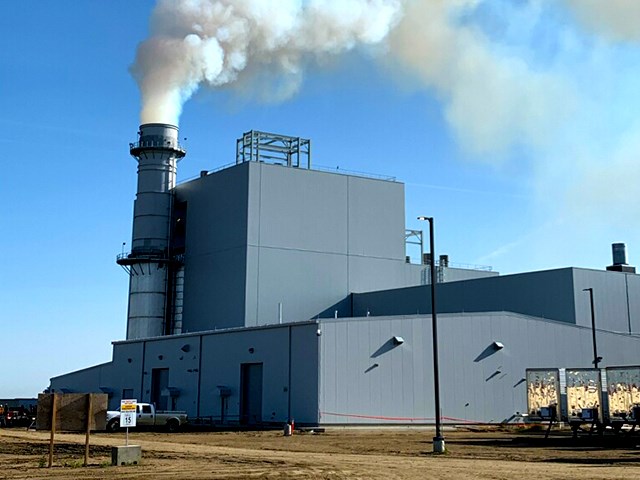Estevan – Several times during the announcement of $10 million in coal transition money for Estevan and Coronach on Feb. 28, Premier Scott Moe referenced the possibility of natural gas-fired power generation, and specifically spoke of taking advantage of existing transmission line infrastructure.
This is the first reference Pipeline Newshas heard of that option for southeast Saskatchewan.
Asking Moe about that, and what the impact of a carbon tax would be on such a decision, he replied, “If we’re successful at the Supreme Court of Canada, which I entirely expect we will be after the Alberta Court of Appeal, a carbon tax won’t come into play with a natural gas plant, if it happens to be chosen here.”
If a natural gas-fired power plant were to come to southeast Saskatchewan, what would that mean?
The last decade has seen SaskPower put up or contract a lot of wind turbines, but more significantly, it has put the bulk of its efforts into natural gas-fired power generation. This includes expanding Saskatoon’s Queen Elizabeth Power Station in 2015 to 16 units generating a total of 634 megawatts.
Natural gas-fired power generation is also used to backstop wind turbines, for times when there is insufficient wind, or it is too cold for the turbines and they must shut down operation.
Over the past 10 years, SaskPower has contracted 250 megawatts of baseload power generation from Northlands Power at North Battleford, built and recently put into operation the 350-megawatt Chinook Power Station at Swift Current, and decided to go ahead with construction of another 350-megawatt power station at Moose Jaw, to be in service by 2024. Each 350-megawatt plant will provide enough power to service a city the size of Saskatoon, according to SaskPower’s website.
North Battleford, Swift Current and Moose Jaw are all combined cycle natural gas power plants, which produce roughly half the greenhouse gas emissions of conventional coal-fired power plants.
In addition, SaskPower in 2010 built a less efficient, simple cycle natural gas three-unit peaking plant at North Battleford called the Yellowhead Power Station which generates 138 megawatts. It contracted Northland Power for an 89-megawatt, two-unit facility at Spy Hill, near Esterhazy. It opened in 2011. Â
The province had “pumped the breaks,” on the Moose Jaw plant in mid-2019 when the federal government decided to apply the federal carbon tax on emissions from plants built after 2021. Later in the year, the decision was made to go ahead with Moose Jaw’s plant.
The one-unit Chinook plant cost $605 million and employed 500 people during construction. It also required a 200-kilometre transmission line from the Pasqua Switching Station to the Swift Current Switching Station. In operation, it permanently employs 25 workers, according to SaskPower.
To replace the Boundary Dam Power Station, which currently produces 672 megawatts, would require two units of the size of Chinook. When all six units were operating, Boundary Dam used to produce over 800 megawatts. Units 1 and 2, at 75 megawatts each, were retired before Unit 3, with its carbon capture plant, was refurbished and went online in late 2014. Unit 4 and 5, at 150 megawatts each, are to be retired in 2021 and 2024, respectively. SaskPower and the province have thus far expressed their intention to continue operating Unit 3 and its carbon capture plant, as its reduced emissions are key to a hard-won equivalency agreement for reducing the overall emissions of the rest of the coal fleet.
The Chinook and Moose Jaw plants are both within close proximity of the TC Energy (formerly TransCanada) mainline, and thus would have access to ample natural gas supply.
There are several gas plants in southeast Saskatchewan, now owned by Steel Reef Infrastructure Corp. All of those process associated gas from local oil production and are tied into the TransGas grid.
However, if local gas production is not sufficient, North Dakota’s burgeoning Bakken oilfield could be a nearby source. TransGas’ grid map indicates an international interconnection to the U.S. south of Estevan.
That state has made it a priority to reduce flaring as much as possible, such that to get a new oil well drilling license, you must submit your gas conservation plan at the same time. This has driven a boom of gas plant construction in the state in recent years. It could potentially provide a plentiful, and likely inexpensive, source of natural gas. According to the U.S. Energy Information Agency, the price for natural gas sold to power production consumers in the state in December, 2019, was US$2.76 per thousand cubic feet. That’s close to the bottom end of its price scale over the last 17 years.
As for a location, the Shand Power Station was built with the intention of building a second unit at the later date. That land is still mostly open, with the exception of the Carbon Capture Test Facility, and could be a possible location.




